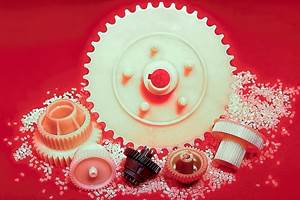Carbon-Fiber Reinforced PPA for Structural Automotive and Electronic Components
BASF’s new Ultramid Advanced N PPA now offered with carbon fiber reinforcement for a broad range of auto applications and electronics.
Positioned to replace aluminum and magnesium in a broad range of structural automotive and consumer electronics applications are the latest addition to the Ultramid Advanced N (PA9T) PPA from BASF Performance Materials, are carbon-reinforced (CF) grades. The Ultramid Advanced N PPA portfolio has been expanded with 20%, 30%, and 40% carbon-fiber reinforced grades for the production of extremely lightweight parts that can safely replace aluminum and magnesium without loss in stiffness and strength and are also electrically conductive.
The new grades combine these properties with the advantages of Ultramid Advanced which reportedly makes them unique among carbon-fiber reinforced PPAs already available in the market: high dimensional stability due to low water uptake, excellent chemical and hydrolysis resistance, high strength and modulus. The new CF reinforced grades can be used to manufacture automotive structural parts for body, chassis and powertrain, for pumps, fans, gears and compressors in industrial applications as well as for stable and ultra-lightweight components in consumer electronics.
The mechanical performance of the new CF PPA grades can be tuned by the choice and the content of the carbon fiber as well as by the additive technology. Ultramid Advanced N3HC8 with 40% carbon fiber content shows a better strength and modulus at 80 C/176 F (conditioned) than magnesium or aluminum. Said Michael Pilarski from BASF’s PPA business management, "Our new PPA compounds with carbon fibers are the ideal metal replacement. And this not only from a material property point of view. Lately, we have seen safety issues at magnesium producers in different countries, which makes the supply rather unpredictable. Producing parts out of magnesium or aluminum also requires additional postprocessing and tooling which increases system costs. Given the opportunities for 25 to 30% weight reduction with our new PPA grades, we can offer a safe, cost-efficient and high-performance alternative for parts traditionally manufactured from metal."

According to the company, combining these new materials with BASF’s Ultrasim simulation software to correctly model part behavior and optimize mold geometry, the Ultramid Advanced CF grades can thus contribute to functional integration and weight reduction in different industries: the range of cars with e-drive or fuel cell engines can be increased by weight reduction of structural or powertrain parts; lightweight, thin precision structures in consumer electronics benefit from the high stiffness and strength, the excellent dimensional stability as well as the extremely low weight and the good processability of the new PPA materials; heavy, highly loaded and longlasting industrial equipment like pumps and compressors can be easily produced because of the good dimensional stability as well as the high chemical, heat and abrasion resistance of the new CF grades.
The CF PPA compounds also show a lower weight and higher tensile modulus than glass-fiber reinforced nylons with similar reinforcements. PPA grades reinforced with 20% carbon fibers are about 20% lighter than nylons 6 and 66 filled with 50% glass fibers. The tensile strength of a 20% CF Ultramid Advanced compound is either better or equivalent to a glass fiber reinforced nylon filled with 50% while showing better processability. Ultramid Advanced N3HC8 e.g. is very stable after aging at high temperatures: It retains nearly 100% of its tesile modulus after heat aging at 120 C/248 F for 5,000 hours or at 150 C/302 F for 3,000 hours.
BASF’s Ultramid Advanced PPA portfolio is based on four polymers: PA9T, T1000 (PA6T/6I), T2000 (PA6T/66) and the long-standing T KR (PA6T/6). They open the door to the next generation of lightweight, high-performance plastic components in many different sectors including the automotive industry, electronics and electric devices, mechanical engineering and consumer goods. Available globally, the PPA portfolio includes more than 50 compounded grades for injection molding and extrusion, products with or without flame retardants. The compounds are available in different colors, from colorless to laser-markable black, with short-glass, long-glass or carbon fiber reinforcement, and with various heat stabilizers.
Related Content
Prices for All Volume Resins Head Down at End of 2023
Flat-to-downward trajectory for at least this month.
Read MoreThe Fantasy and Reality of Raw Material Shelf Life: Part 1
Is a two-year-old hygroscopic resin kept in its original packaging still useful? Let’s try to answer that question and clear up some misconceptions.
Read MoreLanxess and DSM Engineering Materials Venture Launched as ‘Envalior’
This new global engineering materials contender combines Lanxess’ high-performance materials business with DSM’s engineering materials business.
Read MoreTracing the History of Polymeric Materials: Aliphatic Polyketone
Aliphatic polyketone is a material that gets little attention but is similar in chemistry to nylons, polyesters and acetals.
Read MoreRead Next
Understanding Melting in Single-Screw Extruders
You can better visualize the melting process by “flipping” the observation point so that the barrel appears to be turning clockwise around a stationary screw.
Read MoreWhy (and What) You Need to Dry
Other than polyolefins, almost every other polymer exhibits some level of polarity and therefore can absorb a certain amount of moisture from the atmosphere. Here’s a look at some of these materials, and what needs to be done to dry them.
Read MoreProcessor Turns to AI to Help Keep Machines Humming
At captive processor McConkey, a new generation of artificial intelligence models, highlighted by ChatGPT, is helping it wade through the shortage of skilled labor and keep its production lines churning out good parts.
Read More















.png;maxWidth=300;quality=90)









